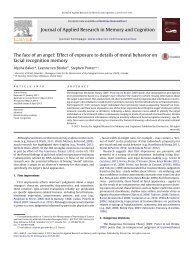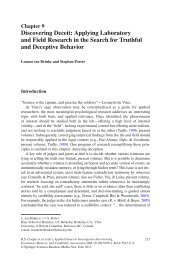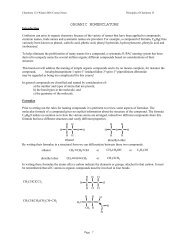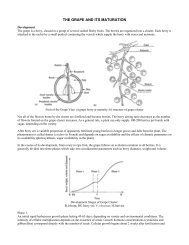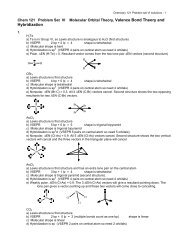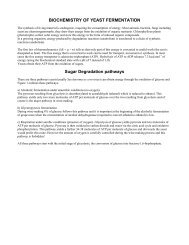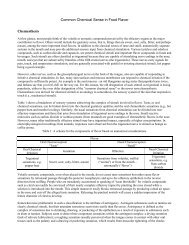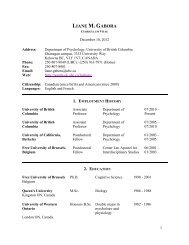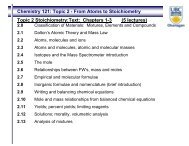A case study in forensic chemistry: The Bali bombings - People
A case study in forensic chemistry: The Bali bombings - People
A case study in forensic chemistry: The Bali bombings - People
You also want an ePaper? Increase the reach of your titles
YUMPU automatically turns print PDFs into web optimized ePapers that Google loves.
Abstract<br />
Talanta 67 (2005) 262–268<br />
A <strong>case</strong> <strong>study</strong> <strong>in</strong> <strong>forensic</strong> <strong>chemistry</strong>: <strong>The</strong> <strong>Bali</strong> bomb<strong>in</strong>gs<br />
David Royds a,∗ , Simon W. Lewis b , Amelia M. Taylor b<br />
a Australian Federal Police Forensic Service, Box 401, Canberra 2601, Australia<br />
b School of Biological and Chemical Sciences, Deak<strong>in</strong> University, Geelong, Vic. 3217, Australia<br />
Received 21 June 2004; accepted 10 March 2005<br />
Available onl<strong>in</strong>e 25 May 2005<br />
<strong>The</strong> <strong>Bali</strong> bomb<strong>in</strong>gs on 12 October 2002 killed 202 people and caused <strong>in</strong>ternational outrage. <strong>The</strong> police <strong>in</strong>vestigation referred to as “Operation<br />
Alliance” <strong>in</strong>volved the Indonesian National Police, the Australian Federal Police and others, resulted <strong>in</strong> the arrests of key personnel and exposed<br />
the l<strong>in</strong>k between Jemaah Islamiah (JI) and al-Queda.<br />
This paper describes aspects of the <strong>in</strong>vestigation from a <strong>forensic</strong> chemists perspective. <strong>The</strong> recovery of water soluble residues from blast<br />
scenes and suspect’s residences is a challeng<strong>in</strong>g task that requires a meticulous and methodical approach. <strong>The</strong> concept of deploy<strong>in</strong>g <strong>forensic</strong><br />
chemists and sett<strong>in</strong>g up a “mobile laboratory” from the outset proved to be a highly effective and efficient way to process large numbers of<br />
samples and assist <strong>in</strong>vestigators with relevant <strong>in</strong>formation at the time that it was most needed. It also identified the need for a new generation<br />
of field portable <strong>in</strong>struments.<br />
© 2005 Elsevier B.V. All rights reserved.<br />
Keywords: Case <strong>study</strong>; Improvised explosives; Operation Alliance; Mobile laboratory; <strong>Bali</strong> bomb<strong>in</strong>g<br />
1. Introduction<br />
<strong>The</strong> bomb<strong>in</strong>gs that occurred <strong>in</strong> <strong>Bali</strong> on the 12 October<br />
2002, were the most callous act of terrorism <strong>in</strong> Australian<br />
history. It was a typical busy Saturday night <strong>in</strong> the ma<strong>in</strong> tourist<br />
area of Kuta when, shortly after 11.00 pm a bomb exploded <strong>in</strong><br />
Paddy’s Bar. Moments later a second and much larger bomb<br />
exploded on the roadway outside the popular Sari night club,<br />
and then a third bomb, which was small <strong>in</strong> comparison to the<br />
first two devices, exploded approximately 10 km away, near<br />
the United States and Australian Consulates. Two hundred<br />
and two people were killed of which 88 were Australians,<br />
and many hundreds more were <strong>in</strong>jured.<br />
Initial reports from that night started with a suggestion that<br />
gas cyl<strong>in</strong>ders had exploded. Stories of confusion, panic and<br />
destruction were relayed back to Australia. Two Australian<br />
Federal Police (AFP) <strong>forensic</strong> officers travell<strong>in</strong>g to Jakarta<br />
were redirected to the scene to make an assessment. <strong>The</strong>y<br />
∗ Correspond<strong>in</strong>g author. Tel.: +61 2 6287 0383; fax: +61 2 6287 0270.<br />
E-mail address: david.royds@afp.gov.au (D. Royds).<br />
0039-9140/$ – see front matter © 2005 Elsevier B.V. All rights reserved.<br />
doi:10.1016/j.talanta.2005.03.026<br />
reported massive structural damage, burn<strong>in</strong>g motor vehicles<br />
and build<strong>in</strong>gs, emergency personnel struggl<strong>in</strong>g to cope and<br />
a large crater <strong>in</strong> the roadway outside the Sari Club. <strong>The</strong>y<br />
immediately recognised the scene for what it was and <strong>in</strong>itiated<br />
a full police <strong>in</strong>vestigation, which became known as Operation<br />
Alliance.<br />
2. Operation Alliance<br />
<strong>The</strong> Australian Federal Police (AFP) sent a team of <strong>in</strong>vestigative<br />
and <strong>forensic</strong> officers to <strong>Bali</strong> to assist the Indonesian<br />
National Police (INP) <strong>in</strong> their <strong>in</strong>vestigation. Operation Alliance<br />
became the largest <strong>in</strong>vestigation ever undertaken by<br />
any Australian police force and was truly an “alliance” between<br />
the Australian, Indonesian and <strong>in</strong>ternational law enforcement<br />
communities. Although there were many <strong>forensic</strong><br />
facets to the operation, such as the <strong>in</strong>volvement of odontologists,<br />
pathologists, and police disaster victim identification<br />
specialists, this article only relates to some aspects of the<br />
<strong>chemistry</strong> component of the crim<strong>in</strong>al <strong>in</strong>vestigation.
3. Detail of the events of October 12<br />
It is estimated that the Paddy’s Bar explosion <strong>in</strong>volved between<br />
1 and 5 kg of TNT conta<strong>in</strong>ed with<strong>in</strong> five lengths of<br />
PVC pipe of 50 mm diameter sewn <strong>in</strong>to a tartan l<strong>in</strong>ed black<br />
vest worn by the suicide bomber. T<strong>in</strong>y fragments of tartan<br />
fabric were recovered from sites surround<strong>in</strong>g the blast epicentre.<br />
Numerous pieces of metal were also found amongst<br />
the debris and these were found to match fragments recovered<br />
from liv<strong>in</strong>g and deceased victims. Connective tissue and<br />
spatter marks were visible on the ceil<strong>in</strong>g above the epicentre.<br />
<strong>The</strong> common organic high explosive (HE) known as tr<strong>in</strong>itrotoluene<br />
(TNT) was identified <strong>in</strong> this material. <strong>The</strong> notable<br />
absence of a crater and extrapolation of spatter <strong>in</strong>dicated the<br />
position of the bomb to be between 80 and 120 cm above the<br />
floor. This was the first evidence to <strong>in</strong>dicate the <strong>in</strong>volvement<br />
of a suicide bomber. Later, analysis of this biological material<br />
revealed that it had all come from the one <strong>in</strong>dividual. A<br />
dismembered head and two lower legs were found amongst<br />
various body parts at the morgue. As samples for DNA analysis<br />
were be<strong>in</strong>g collected from all the significant body parts as<br />
a rout<strong>in</strong>e part of the Disaster Victim Identification (DVI) process,<br />
it was a simple matter to compare profiles and l<strong>in</strong>k those<br />
parts with the ceil<strong>in</strong>g spatter. <strong>The</strong>se body parts turned out to<br />
be a rich reservoir of precious trace evidence. Investigators,<br />
now aware of this DNA database and suspect<strong>in</strong>g the <strong>in</strong>volvement<br />
of a suicide bomber, sought out that person’s parents <strong>in</strong><br />
order to establish his true identity. To our surprise, the DNA<br />
profile of that union did not match. A further search of the<br />
database however, did <strong>in</strong> fact reveal the presence of this profile<br />
and it was <strong>in</strong> many t<strong>in</strong>y body parts that were found near<br />
the Sari Club. This observation implicated the <strong>in</strong>volvement<br />
of a second suicide bomber.<br />
<strong>The</strong> second and largest device was detonated at the nearby<br />
Sari Club at 11:08 pm, 15 s after the Paddy’s Bar explosion.<br />
It is estimated that over 350 people were <strong>in</strong> the club at this<br />
time. <strong>The</strong> force of the blast was so strong that it registered on<br />
seismographs <strong>in</strong> neighbour<strong>in</strong>g countries. It is estimated that<br />
an improvised explosive mixture with an estimated power<br />
equivalent of 150 kg of TNT had been used. Exhaustive analyses<br />
revealed the presence of the chlorate ion <strong>in</strong> and around<br />
the crater. When arrested the offenders stated the bomb was<br />
made from a mixture of potassium chlorate, sulphur and alum<strong>in</strong>ium,<br />
boosted by TNT. It is now believed that the improvised<br />
explosive mixture, more than 1 tonne <strong>in</strong> total, was<br />
conta<strong>in</strong>ed <strong>in</strong> 12 four-drawer plastic fil<strong>in</strong>g cab<strong>in</strong>ets <strong>in</strong>terconnected<br />
with detonat<strong>in</strong>g chord which is made from another<br />
organic high explosive known as pentaerythritol tetranitrate<br />
(PETN). This device was placed <strong>in</strong> the back of a Mitsubishi<br />
L300 van and parked outside the Sari Club. It was also <strong>in</strong>itiated<br />
by a suicide bomber. Remarkably, some fragments from<br />
this <strong>in</strong>dividual survived the blast and were used to establish<br />
his identity through DNA analysis.<br />
<strong>The</strong> third bomb, referred to <strong>in</strong> the media as the “USA Consulate<br />
Bomb”, was detonated about 10 km away on a public<br />
street near the Unites States and Australian Consulates. It was<br />
D. Royds et al. / Talanta 67 (2005) 262–268 263<br />
made from a relatively small amount of TNT and was <strong>in</strong>itiated<br />
remotely us<strong>in</strong>g a mobile phone about 45 s after the Sari<br />
Club bomb. No <strong>in</strong>juries were caused by this bomb, however<br />
this site was important as it was rich <strong>in</strong> physical evidence.<br />
4. <strong>The</strong> breakthrough<br />
<strong>The</strong> <strong>in</strong>itial breakthrough came about through <strong>forensic</strong> exam<strong>in</strong>ers<br />
from the INP f<strong>in</strong>d<strong>in</strong>g impressed numbers <strong>in</strong> chassis<br />
fragments that survived the ma<strong>in</strong> blast. Although both chassis<br />
and eng<strong>in</strong>e numbers appeared to have been filed away<br />
<strong>in</strong> an attempt to avoid detection, another number otherwise<br />
unknown to the general public had been stamped on the chassis<br />
rail dur<strong>in</strong>g a rout<strong>in</strong>e vehicle <strong>in</strong>spection by the Indonesian<br />
authorities. Through the f<strong>in</strong>d<strong>in</strong>g this number, the INP <strong>in</strong>vestigators<br />
were able to trace the vehicle back to a Javanese<br />
man named Amrozi (referred to <strong>in</strong> the media as “the smil<strong>in</strong>g<br />
assass<strong>in</strong>”) who was a key member of the terrorist gang.<br />
It has subsequently been determ<strong>in</strong>ed that he purchased the<br />
van and chemicals and attended meet<strong>in</strong>gs to plan the crime.<br />
Amrozi confessed and named his co-conspirators Samudra,<br />
Idris, Dulmat<strong>in</strong>, Muklas and Ali Imron.<br />
5. <strong>The</strong> <strong>chemistry</strong><br />
An explosion is merely an energetic reaction that results <strong>in</strong><br />
the rapid release of gas. <strong>The</strong> rate of the reaction determ<strong>in</strong>es the<br />
destructive consequences [1,2]. Improvised explosives us<strong>in</strong>g<br />
<strong>in</strong>organic components such as ammonium nitrate with fuel<br />
oils (ANFO) usually have relatively low velocities of detonation<br />
and are suitable for “push<strong>in</strong>g” applications such as<br />
<strong>in</strong> earthworks and m<strong>in</strong><strong>in</strong>g [3]. ANFO is the most common<br />
explosive used <strong>in</strong> Australia with about 650,000 tonnes used<br />
annually [4]. Organic explosives such as TNT, PETN and<br />
RDX are characterised by high velocities of detonation (up<br />
to 9000 m/s) and have applications <strong>in</strong> detonators, boost<strong>in</strong>g<br />
chargers and military ord<strong>in</strong>ance [5]. Although high explosives<br />
are used to <strong>in</strong>itiate and boost low explosives, they are<br />
usually totally consumed <strong>in</strong> the ensu<strong>in</strong>g reaction and rarely<br />
leave traces for the <strong>forensic</strong> chemist to f<strong>in</strong>d.<br />
Contrary to <strong>in</strong>tuition, but accepted by most experienced<br />
practitioners, large explosions usually leave less tell-tale<br />
residue than smaller ones. Most large bombs are improvised<br />
and made of <strong>in</strong>organic oxidizers such as nitrates, chlorates<br />
and perchlorates and fuels such as diesel oil, sugar, sulphur<br />
or reactive metals such as alum<strong>in</strong>ium dust [2]. <strong>The</strong> release<br />
of such tremendous energy often causes a fire which is <strong>in</strong>variably<br />
fought with water. <strong>The</strong> bomb outside the Sari Club<br />
caused the thatched roofs over the courtyards to catch on fire<br />
and the blast broke a water ma<strong>in</strong> under the roadway caus<strong>in</strong>g<br />
the crater to fill. <strong>The</strong> quantity of post blast residual matter<br />
was reduced through dissolution and be<strong>in</strong>g washed away<br />
down gutters and dra<strong>in</strong>s. <strong>The</strong> warm and humid climate of the<br />
tropics compounded the problem as atmospheric moisture
264 D. Royds et al. / Talanta 67 (2005) 262–268<br />
comb<strong>in</strong>ed with the fuels and carbonaceous materials (traffic<br />
soot) to further reduce the amount of reactive chemicals to<br />
be found (see Fig. 1).<br />
6. <strong>The</strong> <strong>in</strong>cident scene<br />
Good <strong>forensic</strong> science starts at the crime scene where careful<br />
observation is required <strong>in</strong> order to collect important evidence<br />
and reconstruct events [6]. In the <strong>case</strong> of explosion<br />
scenes the <strong>in</strong>formation that can be ga<strong>in</strong>ed concern<strong>in</strong>g the<br />
type of explosive, quantity and bomb architecture is vital<br />
for successful apprehension of the perpetrators [2]. Itisimportant<br />
to ensure details such as the location of the sample<br />
and the identity of every person <strong>in</strong>volved <strong>in</strong> the cha<strong>in</strong> of possession<br />
is accurately recorded and it is also imperative that<br />
the risk of contam<strong>in</strong>ation be m<strong>in</strong>imised from the outset [6].<br />
A professional law enforcement organisation has procedures<br />
<strong>in</strong> place to ensure this occurs and that the <strong>in</strong>tegrity of samples<br />
is ma<strong>in</strong>ta<strong>in</strong>ed from scene to court [6,7]. Crime scenes<br />
where explosions have occurred are particularly challeng<strong>in</strong>g<br />
to process, due to their complexity. Microscopic fragments<br />
of explosive and its residues will be spread throughout a large<br />
amount of post blast debris [2].<br />
7. <strong>The</strong> mobile laboratory<br />
Provision of <strong>in</strong>formation at an early stage <strong>in</strong> an <strong>in</strong>vestigation<br />
is extremely helpful <strong>in</strong> rapid identification of suspects.<br />
<strong>The</strong> AFP deployed part of its mobile laboratory to<br />
<strong>Bali</strong> to assist with the collection of trace evidence and explosive<br />
residues. AFP practice is to set it up as close to the<br />
Fig. 1. Water filled crater outside the Sari Club.<br />
forward command post for security and effective communications,<br />
and as close to the scene as to be convenient, yet<br />
far enough away to m<strong>in</strong>imise the risk of contam<strong>in</strong>ation. A<br />
nearby motel room was cleared and prepared for the <strong>in</strong>stallation<br />
of such <strong>in</strong>struments as a microscope with camera, an ion<br />
mobility spectrometer (IMS), a portable <strong>in</strong>fra-red spectrometer<br />
(FT-IR), and a range of reagents for various presumptive<br />
and other spot tests. Of particular <strong>in</strong>terest were those for<br />
detect<strong>in</strong>g strong oxidizers (diphenylam<strong>in</strong>e reagent, modified<br />
Griess test (nitrites/nitrates), anil<strong>in</strong>e hydrochloride for chlorates,<br />
and others such as Nessler’s for the ammonium ion,<br />
and so on, see Table 1). From lessons learnt <strong>in</strong> <strong>Bali</strong> the AFP<br />
has s<strong>in</strong>ce purchased a portable ion analyser, which is used<br />
for the <strong>in</strong>strumental analysis of these <strong>in</strong>organic ions that are<br />
commonly found <strong>in</strong> improvised explosives.<br />
<strong>The</strong> rationale beh<strong>in</strong>d a mobile laboratory is to produce<br />
timely, albeit tentative f<strong>in</strong>d<strong>in</strong>gs for the <strong>in</strong>vestigators whilst<br />
reduc<strong>in</strong>g the number and volume of samples to be sent<br />
to the ma<strong>in</strong> laboratory for more exhaustive confirmatory<br />
analyses. In such an important <strong>case</strong> as Operation Alliance,<br />
which <strong>in</strong>volved victims from 22 countries and presented<br />
the possibility of a prosecution <strong>in</strong> the International Court,<br />
it was considered prudent to have f<strong>in</strong>d<strong>in</strong>gs corroborated<br />
by other reputable laboratories. On occasions, up to four<br />
samples were collected; one for the ma<strong>in</strong> AFP laboratory <strong>in</strong><br />
Canberra, a duplicate for the host country, and one each for<br />
the Victoria Police Forensic Services Centre (VPFSC) and<br />
the Forensic Explosives Laboratory (FEL), Brita<strong>in</strong>.<br />
<strong>The</strong> contribution of the scientists from Brita<strong>in</strong> was particularly<br />
praiseworthy, for not only did they br<strong>in</strong>g a wealth of<br />
experience to the table dur<strong>in</strong>g the early stages of the <strong>in</strong>vestigation,<br />
they also undertook an environmental survey to establish<br />
the background levels of various ions (<strong>in</strong>clud<strong>in</strong>g chlorate,
Table 1<br />
Colorimetric screen<strong>in</strong>g methods for explosives [1,8,9]<br />
D. Royds et al. / Talanta 67 (2005) 262–268 265<br />
Test Target explosives Colour change<br />
Alcoholic KOH: 3% KOH <strong>in</strong> ethanol TNT Purple/brown<br />
2,4-DNT Yellow<br />
2,6-DNT Yellow<br />
Tetryl Violet<br />
Griess reagent: methanolic N-(1-napthyl)ethylenediam<strong>in</strong>e <strong>in</strong> the presence of sulphanilic acid and z<strong>in</strong>c dust Nitrates and nitrites Purple<br />
Nitrate P<strong>in</strong>k to red<br />
Nitrocellulose P<strong>in</strong>k<br />
Nitroglycer<strong>in</strong> P<strong>in</strong>k to red<br />
PETN P<strong>in</strong>k to red<br />
RDX P<strong>in</strong>k to red<br />
Tetryl P<strong>in</strong>k to red<br />
Diphenylam<strong>in</strong>e: reaction with diphenylam<strong>in</strong>e <strong>in</strong> concentrated sulphuric acid Chlorate Blue<br />
Nitrates Blue<br />
Nitrocellulose Blue-black<br />
Nitroglycer<strong>in</strong> Blue<br />
PETN Blue<br />
RDX Blue<br />
Tetryl Blue<br />
TATP Blue<br />
Anil<strong>in</strong>e hydrochloride: anil<strong>in</strong>e acidified with hydrochloric acid and activated with potassium chlorate Chlorate Blue<br />
Hypochlorite Blue<br />
Chlorite Blue<br />
Nessler’s reagent: mercury-iodide solution (commercially available) Ammonium ions Yellow/brown<br />
Nitroglycer<strong>in</strong> Black<br />
TNT Red<br />
nitrate and so on). This is essential <strong>in</strong>formation from a scientific<br />
perspective.<br />
8. <strong>The</strong> analytical approach<br />
<strong>The</strong> approach taken <strong>in</strong> analys<strong>in</strong>g post debris starts with a<br />
number of presumptive tests (see Table 1). <strong>The</strong>se presumptive<br />
tests generally <strong>in</strong>volve reactions result<strong>in</strong>g <strong>in</strong> a dist<strong>in</strong>ctive<br />
colour. <strong>The</strong>se tests require careful use of blanks and positive<br />
controls to ensure valid results, and while rapid they<br />
are not def<strong>in</strong>itive [1,2,8,9]. Samples that yield promis<strong>in</strong>g results<br />
are collected and packaged for further exam<strong>in</strong>ations<br />
and analysis <strong>in</strong> the laboratory (see Table 2) [1,9]. <strong>The</strong> level<br />
of confidence rises with each positive result. A satisfactory<br />
level of confidence <strong>in</strong> establish<strong>in</strong>g the identity of a questioned<br />
sample is generally achieved after corroboration from<br />
two <strong>in</strong>dependent techniques. This is known as “orthogonal”<br />
test<strong>in</strong>g.<br />
Orthogonal test<strong>in</strong>g is relatively easy to achieve when deal<strong>in</strong>g<br />
with bulk material. For example, a very high level of<br />
confidence would be expressed <strong>in</strong> an identification based<br />
on an <strong>in</strong>fra-red spectrum and a chromatogram where retention<br />
times have been shown to be precise and reproducible.<br />
<strong>The</strong> problem becomes more difficult when deal<strong>in</strong>g with trace<br />
quantities, and especially so when they are from an <strong>in</strong>organic<br />
source which may occur naturally <strong>in</strong> the environment, or if<br />
they are volatile and unlikely to persist <strong>in</strong> the area. It could<br />
be argued (and was) that although chlorates are not normally<br />
found <strong>in</strong> the environment, it may be possible <strong>in</strong> such a scene<br />
to have detected residues of unburnt matches that fell from<br />
victims dur<strong>in</strong>g or after the blast! For this reason, elevated<br />
surfaces were preferred sites for sampl<strong>in</strong>g.<br />
Some <strong>forensic</strong> explosive laboratories favour liquid<br />
chromatography <strong>in</strong> comb<strong>in</strong>ation with mass spectrometry<br />
(LC–MS) as the pr<strong>in</strong>ciple technique [10], whilst others prefer<br />
gas chromatography with either a thermal energy analyser<br />
(GC–TEA) [11,12], which is specific for compounds conta<strong>in</strong><strong>in</strong>g<br />
the nitro and nitroso functional groups; or positive<br />
and/or negative ion chemical ionisation mass spectrometry<br />
(GC–nciMS) detectors [9,13].<br />
Time of flight mass spectrometry (TOF-MS) can get past<br />
the problem of thermal <strong>in</strong>stability by perform<strong>in</strong>g very rapid<br />
analyses us<strong>in</strong>g a short narrow bore column, and deconvolut<strong>in</strong>g<br />
the result<strong>in</strong>g chromatogram by exceed<strong>in</strong>gly rapid mass<br />
spectral analysis. This however raises the question as to<br />
whether it is truly orthogonal test<strong>in</strong>g for if the chromatography<br />
does not resolve co-elut<strong>in</strong>g compounds, then is it really<br />
only the one technique?<br />
Capillary electrophoresis (CE) was viewed as the emerg<strong>in</strong>g<br />
technology to displace ion chromatography (IC) as the<br />
preferred method for the analysis of <strong>in</strong>organic ions [13]. It<br />
seemed to have the greatest promise for conversion to m<strong>in</strong>iaturisation<br />
to produce field-portable units. Certa<strong>in</strong>ly the CE<br />
technique has acceptable detection limits and the capacity<br />
to resolve ions with an extraord<strong>in</strong>ary number of theoretical
266 D. Royds et al. / Talanta 67 (2005) 262–268<br />
Table 2<br />
Analytical methods for explosive residue analysis [1,9–13]<br />
Analytical method Target explosives Detection limit Advantages Limitations<br />
TLC Organica g to sub-g Simple <strong>in</strong>expensive rapid Low resolution susceptible to contam<strong>in</strong>ation<br />
GC–ECD Nitrogen-conta<strong>in</strong><strong>in</strong>gb pg Rapid selective highly sensitive for Requires volatile analytes <strong>in</strong>sensitive to<br />
nitrogen-conta<strong>in</strong><strong>in</strong>g compounds hydrocarbons<br />
GC–TEA Nitro-conta<strong>in</strong><strong>in</strong>gc pg Sensitive and selective for nitro Requires volatile analytes expensive limited<br />
compounds<br />
to nitro compounds<br />
HPLC-UV or DA Organica ng Sensitive Low selectivity<br />
IR Organica and <strong>in</strong>organicd g Universal organic and <strong>in</strong>organic<br />
compounds have characteristic spectra<br />
Residues require separation prior to analysis<br />
MS Organica and <strong>in</strong>organicd pg to ng Rapid selective sensitive reliable<br />
GC–MS Organica (low bp)<br />
plasticizerse stabilisersf pg to ng Rapid selective reliable sensitive Limited to volatiles<br />
LC–MS Organica pg to ng Analysis of non-volatiles Requires <strong>in</strong>terface between HPLC and MS<br />
SEM/EDX Inorganicd Organic and <strong>in</strong>organic samples Expensive, requires expert operators<br />
a Organic explosives: DNT, TNT, EGDN, NG, PETN, NC, RDX, HMX, TATP, HMTD.<br />
b Nitrogen-conta<strong>in</strong><strong>in</strong>g explosives: DNT, TNT, picric acid, EGDN, NG, PETN, NC, nitrate salts.<br />
c Nitro explosives: DNT, TNT, picric acid, EGDN, NG, PETN, NC, RDX, HMX. RDX, HMX, nitrate salts, black powder.<br />
d Inorganic explosives: nitrate and chlorate salts.<br />
e Plasticizers: phthalate and sebacate esters.<br />
f Stabilisers: diphenylam<strong>in</strong>e (DPA), ethyl centralite (EC).<br />
plates; however it has fallen out of favour with many analysts<br />
due to difficulties <strong>in</strong> obta<strong>in</strong><strong>in</strong>g reproducible migration times.<br />
In order to mount an argument that an <strong>in</strong>organic ion<br />
was part of the explosive mixture, the <strong>forensic</strong> analyst must<br />
demonstrate its concentration to be significantly higher <strong>in</strong> and<br />
around the crater than <strong>in</strong> the background. A large number of<br />
analyses may be required to achieve this objective. At this<br />
stage of technological development there are no <strong>in</strong>struments<br />
available on the market for such applications.<br />
<strong>The</strong> total number of samples analysed at the AFP laboratory<br />
was <strong>in</strong> excess of 2000 (ca. 2400). Many of these were<br />
items of cloth<strong>in</strong>g recovered from victims as they returned to<br />
Australia. <strong>The</strong> chlorate ion was identified <strong>in</strong> a small number<br />
Fig. 2. <strong>The</strong> newspaper with a barely visible footpr<strong>in</strong>t on its surface.<br />
of samples (six <strong>in</strong> total), however this is a remarkable observation<br />
<strong>in</strong> itself as such a reactive ion is unlikely to persist<br />
<strong>in</strong> the environment. Notably, it was recovered from crevices<br />
<strong>in</strong> the bitumen surface of the blast crater, and on elevated<br />
surfaces of lamp posts fac<strong>in</strong>g the blast.<br />
Scientists from the FEL searched the pitt<strong>in</strong>g <strong>in</strong> the soft<br />
alum<strong>in</strong>ium of street signs that had been retrieved from nearby<br />
roof tops us<strong>in</strong>g an SEM EDX. <strong>The</strong>y reported elevated levels<br />
of chloride, low levels of chlorate and but only marg<strong>in</strong>ally<br />
higher than background levels of potassium. Sulphur was not<br />
detected.<br />
Soils from <strong>in</strong> and around the blast seat were analysed<br />
by scientists from the AFP us<strong>in</strong>g X-ray fluorescence
spectroscopy. No evidence was found to <strong>in</strong>dicate higher than<br />
background levels of any of the elements implicated.<br />
<strong>The</strong> organic explosive TNT was detected us<strong>in</strong>g IMS at<br />
the two other scenes and confirmation was achieved by both<br />
GC–TEA and GC–nciMS.<br />
<strong>The</strong> f<strong>in</strong>d<strong>in</strong>gs of the AFP <strong>in</strong> relation to chlorate and TNT<br />
were corroborated by the VPFSC and the FEL us<strong>in</strong>g different<br />
procedures and techniques. As the police <strong>in</strong>vestigation<br />
D. Royds et al. / Talanta 67 (2005) 262–268 267<br />
Fig. 3. <strong>The</strong> footpr<strong>in</strong>t <strong>in</strong> alum<strong>in</strong>ium dust on a black gelat<strong>in</strong> lift.<br />
progressed, confessions from the accused added further corroboration<br />
with TNT, potassium chlorate, sulphur and alum<strong>in</strong>ium<br />
be<strong>in</strong>g volunteered as the <strong>in</strong>gredients for the ma<strong>in</strong><br />
Sari Club bomb, and TNT be<strong>in</strong>g the ma<strong>in</strong> charge <strong>in</strong> both the<br />
other bombs.<br />
It should be borne <strong>in</strong> m<strong>in</strong>d that these bomb scene analyses<br />
formed part of wider <strong>in</strong>vestigation. About 4 months after<br />
the <strong>in</strong>cident the police <strong>in</strong>vestigators led the <strong>forensic</strong> team to a<br />
Fig. 4. A microscopic particle of potassium chlorate, sulphur and alum<strong>in</strong>ium found <strong>in</strong> vacuum<strong>in</strong>gs from suspect premises.
268 D. Royds et al. / Talanta 67 (2005) 262–268<br />
suburban dwell<strong>in</strong>g <strong>in</strong> Denpasar where it was alleged the bomb<br />
was constructed. Although an <strong>in</strong>itial cursory <strong>in</strong>spection provided<br />
little encouragement, a mass of physical, chemical and<br />
trace evidence was harvested from this scene. To mention but<br />
two, m<strong>in</strong>ute particles of the explosive mixture were recovered<br />
from vacuum<strong>in</strong>gs taken from the gaps <strong>in</strong> the tiled floor and<br />
a barely visible footpr<strong>in</strong>t <strong>in</strong> alum<strong>in</strong>ium dust was found on a<br />
sheet of newspaper (see Figs. 2–4).<br />
9. Conclusion<br />
<strong>The</strong> “mobile laboratory” concept proved to be effective <strong>in</strong><br />
provid<strong>in</strong>g valuable <strong>in</strong>formation to the <strong>in</strong>vestigators at a time<br />
when it was most needed.<br />
A multi-jurisdictional response is the most appropriate<br />
way to effectively deal with an <strong>in</strong>cident <strong>in</strong>volv<strong>in</strong>g mass casualties<br />
from many nationalities because it allowed the <strong>in</strong>dependent<br />
<strong>forensic</strong> strengths of each jurisdiction to be shared,<br />
whilst reduc<strong>in</strong>g the workload on <strong>in</strong>dividuals. A high level of<br />
confidence can be expressed when different laboratories from<br />
different jurisdictions arrive at the same conclusion us<strong>in</strong>g<br />
their own <strong>in</strong>dependently developed and validated methods.<br />
<strong>The</strong> <strong>forensic</strong> chemist’s contribution to Operation Alliance<br />
was significant and helped lead to the early arrests of offenders,<br />
thus thwart<strong>in</strong>g another similar <strong>in</strong>cident from occurr<strong>in</strong>g<br />
and sav<strong>in</strong>g countless unknown lives and suffer<strong>in</strong>g.<br />
10. Personal comments (David Royds)<br />
Participation <strong>in</strong> an <strong>in</strong>vestigation of this magnitude demands<br />
an <strong>in</strong>tensity of purpose that normally protects one from<br />
jo<strong>in</strong><strong>in</strong>g <strong>in</strong> the bereavement journey of the relatives mourn<strong>in</strong>g<br />
their loved ones. But <strong>in</strong> its enormity there were periods of<br />
frustration caused largely by <strong>in</strong>strument failure, and tedium<br />
that made it difficult to manage until the results of our work<br />
turned those feel<strong>in</strong>gs of hopelessness to exhilaration.<br />
<strong>The</strong> <strong>Bali</strong> bomb<strong>in</strong>gs confirmed my deeply held belief that<br />
<strong>forensic</strong> scientists should aspire to develop a broad understand<strong>in</strong>g<br />
of a wide range of evidence types <strong>in</strong> order to be<br />
most effective <strong>in</strong> such situations. Scientists must be able to<br />
work <strong>in</strong> the morgue to recover evidence from bodies, exam<strong>in</strong>e<br />
scenes and <strong>in</strong>terpret the damage so as to collect material that<br />
is most likely to produce evidence, search suspect premises<br />
whilst m<strong>in</strong>imis<strong>in</strong>g the potential for cross contam<strong>in</strong>ation, and<br />
conduct a wide range of analyses <strong>in</strong> the laboratory, <strong>in</strong>clud<strong>in</strong>g<br />
fibre exam<strong>in</strong>ations, pa<strong>in</strong>t and plastic analysis as well as post<br />
blast explosive residue analysis, and <strong>in</strong>terpret all the scientific<br />
observations <strong>in</strong> an objective manner.<br />
In h<strong>in</strong>dsight, it was a privilege to be <strong>in</strong>volved <strong>in</strong> Operation<br />
Alliance with friendships be<strong>in</strong>g forged between like-m<strong>in</strong>ded<br />
people from around the world. <strong>The</strong> unify<strong>in</strong>g effect of a world<br />
outraged by the senseless acts of a religious fundamentalist<br />
m<strong>in</strong>ority will ensure those who use terrorism will not w<strong>in</strong>.<br />
Acknowledgements<br />
David Royds would like to acknowledge his colleagues<br />
Ben Kwok, Sarah Benson and Dr. Naomi Jones who worked<br />
selflessly toward our common goal. He would also acknowledge<br />
and thank Dr. Jim Pearson, John Kelleher and George<br />
Xydias from the Victoria Police Forensic Service Centre for<br />
br<strong>in</strong>g<strong>in</strong>g their knowledge and expertise to the fore <strong>in</strong> this complex<br />
<strong>in</strong>vestigation. <strong>The</strong>y made many important contributions<br />
that assured the success of Operation Alliance.<br />
References<br />
[1] R. Saferste<strong>in</strong>, Crim<strong>in</strong>alistics: An Introduction to Forensic Science,<br />
Pearson Education Inc, New Jersey, USA, 2004.<br />
[2] H.J. Yallop, Explosion Investigation, Scottish Academic Press Ltd,<br />
Ed<strong>in</strong>burgh, Scotland, 1980.<br />
[3] S.G. Murray, <strong>in</strong>: J.A. Siegel, P.J. Saukko, G.C. Knupfer (Eds.), Explosives/Commercial<br />
<strong>in</strong> Encyclopaedia of Forensic Science, vol. 2,<br />
Academic Press, UK, 2000, pp. 750–758.<br />
[4] Queensland Government Department of Natural Resources and<br />
M<strong>in</strong>es, Key po<strong>in</strong>ts for discussion regard<strong>in</strong>g the regulation of security<br />
sensitive ammonium nitrate (SSAN), 2004. http://www.nrm.qld.<br />
gov.au/m<strong>in</strong>es/explosives/pdf/ssan discussion.pdf (accessed 7 March<br />
2005).<br />
[5] S.G. Murray, <strong>in</strong>: J.A. Siegel, P.J. Saukko, G.C. Knupfer (Eds.), Explosives/Military<br />
<strong>in</strong> Encyclopaedia of Forensic Science, vol. 2, Academic<br />
Press, UK, 2000, pp. 764–771.<br />
[6] N. Weston, <strong>in</strong>: P.C. White (Ed.), <strong>The</strong> Crime Scene <strong>in</strong> Crime Scene<br />
to Court—<strong>The</strong> Essentials of Forensic Science, <strong>The</strong> Royal Society of<br />
Chemistry, Cambridge, UK, 2004, pp. 21–55.<br />
[7] P. Meikle, <strong>in</strong>: J.A. Siegel, P.J. Saukko, G.C. Knupfer (Eds.),<br />
Explosives/Bomb-scene Management <strong>in</strong> Encyclopaedia of Forensic<br />
Science, vol. 2, Academic Press, UK, 2000, pp. 745–750.<br />
[8] S. Palenik, <strong>in</strong>: J.A. Siegel, P.J. Saukko, G.C. Knupfer (Eds.), Micro<strong>chemistry</strong><br />
<strong>in</strong> Encyclopaedia of Forensic Science, vol. 3, Academic<br />
Press, UK, 2000, pp. 1111–1116.<br />
[9] T. Tamiri, <strong>in</strong>: J.A. Siegel, P.J. Saukko, G.C. Knupfer (Eds.), Explosives/Analysis<br />
<strong>in</strong> Encyclopaedia of Forensic Science, vol. 2, Academic<br />
Press, UK, 2000, pp. 729–745.<br />
[10] J. Y<strong>in</strong>on, <strong>in</strong>: J. Y<strong>in</strong>on (Ed.), Analysis of Explosives by LC/MS <strong>in</strong> Advances<br />
<strong>in</strong> Forensic Applications of Mass Spectrometry, CRC Press,<br />
Boca Raton, 2004.<br />
[11] P. Kolla, A. Sprunkel, J. Forensic Sci. 40 (1995) 406.<br />
[12] A.M. Jiménez, M.J. Navas, J. Hazard. Mater. A 106 (2004) 1.<br />
[13] J. Y<strong>in</strong>on, <strong>in</strong>: M.C. Bogusz (Ed.), Explosives <strong>in</strong> Handbook of Analytical<br />
Separations, vol. 2, Elsevier, Amsterdam, 2000, pp. 603–616.



